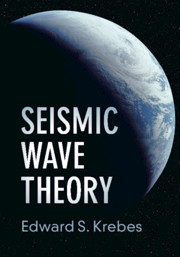Book contents
- Frontmatter
- Dedication
- Contents
- Preface
- Symbols
- 1 Vectors, Tensors, and Fourier Transforms
- 2 Stress, Strain, and Seismic Waves
- 3 Reflection and Transmission of Plane Waves
- 4 Surface Waves, Head Waves, and Normal Modes
- 5 Waves in Heterogeneous Media
- 6 Data Transformations
- 7 Synthetic Seismograms
- 8 Seismic Migration
- 9 Plane Waves in Anisotropic Media
- 10 Plane Waves in Anelastic Media
- Answers to Selected Exercises
- References
- Index
4 - Surface Waves, Head Waves, and Normal Modes
Published online by Cambridge University Press: 15 March 2019
- Frontmatter
- Dedication
- Contents
- Preface
- Symbols
- 1 Vectors, Tensors, and Fourier Transforms
- 2 Stress, Strain, and Seismic Waves
- 3 Reflection and Transmission of Plane Waves
- 4 Surface Waves, Head Waves, and Normal Modes
- 5 Waves in Heterogeneous Media
- 6 Data Transformations
- 7 Synthetic Seismograms
- 8 Seismic Migration
- 9 Plane Waves in Anisotropic Media
- 10 Plane Waves in Anelastic Media
- Answers to Selected Exercises
- References
- Index
Summary
Surface waves are waves that are essentially confined to the surface of the Earth, in that their amplitudes decrease with depth in some way. This chapter covers the basic theory of such waves, as well as the theory of normal modes, which are waves confined to a surface layer, and are similar to waves in an organ pipe or the motions of a vibrating string fixed at one end or both ends, for instance. Coverage includes Rayleigh waves, which are a combination of compressional and shear waves and produce ground motions parallel to the vertical plane in which the wave is traveling, and are a dominant type of earthquake wave; and Love waves, which are shear waves that produce ground motions in the horizontal plane, and head waves, which are upgoing waves produced by critically refracted transmitted waves. Waves along an interface between two solids are also discussed. Also discussed are how the different frequencies in the wave pulse travel at different wave speeds, and the corresponding concepts of phase and group velocity.In addition, other types of normal modes are covered, as well as an interesting wave phenomenon known as the Airy phase.
Keywords
- Type
- Chapter
- Information
- Seismic Wave Theory , pp. 152 - 186Publisher: Cambridge University PressPrint publication year: 2019
- 1
- Cited by

